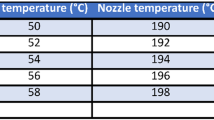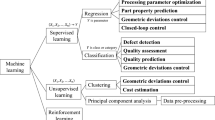Abstract
Additive manufacturing (AM), as a fast-developing technology for rapid manufacturing, offers a paradigm shift in terms of process flexibility and product customisation, showing great potential for widespread adoption in the industry. In recent years, energy consumption has increasingly attracted attention in both academia and industry due to the increasing demands and applications of AM systems in production. However, AM systems are considered highly complex, consisting of several subsystems, where energy consumption is related to various correlated factors. These factors stem from different sources and typically contain features with various types and dimensions, posing challenges for integration for analysing and modelling. To tackle this issue, a hybrid machine learning (ML) approach that integrates extreme gradient boosting (XGBoost) decision tree and density-based spatial clustering of applications with noise (DBSCAN) technique, is proposed to handle such multi-source data with different granularities and structures for energy consumption prediction. In this paper, four different sources, including design, process, working environment, and material, are taken into account. The unstructured data is clustered by DBSCAN so to reduce data dimensionality and combined with handcrafted features into the XGBoost model for energy consumption prediction. A case study was conducted, focusing on the real-world SLS system to demonstrate the effectiveness of the proposed method.
Access this chapter
Tax calculation will be finalised at checkout
Purchases are for personal use only
Similar content being viewed by others
References
ASTM International: Standard Terminology for Additive Manufacturing Technologies. ASTM International, West Conshohocken, PA (2012)
Watson, J.K., Taminger, K.M.B.: A decision-support model for selecting additive manufacturing versus subtractive manufacturing based on energy consumption. J. Clean. Prod. 176, 1316–1322 (2018)
Wang, L., Alexander, C.A.: Additive manufacturing and big data. Int. J. Math. Eng. Manage. Sci. 1(3), 107–121 (2016)
Kellens, K., Baumers, M., Gutowski, T.G., Flanagan, W., Lifset, R., Duflou, J.R.: Environmental dimensions of additive manufacturing: mapping application domains and their environmental implications. J. Ind. Ecol. 21, S49–S68 (2017)
Yang, Y., Li, L., Pan, Y., Sun, Z.: Energy consumption modeling of stereolithography-based additive manufacturing toward environmental sustainability. J. Ind. Ecol. 21, S168–S178 (2017)
Freitas, D., Almeida, H.A., Bártolo, H., Bártolo, P.J.: Sustainability in extrusion-based additive manufacturing technologies. Prog. Addit. Manuf. 1(1–2), 65–78 (2016). https://doi.org/10.1007/s40964-016-0007-6
Ahuett-Garza, H., Kurfess, T.: A brief discussion on the trends of habilitating technologies for Industry 4.0 and Smart manufacturing. Manuf. Lett. 15, 60–63 (2018)
Qin, J., Liu, Y., Grosvenor, R.:Multi-source data analytics for AM energy consumption prediction. Adv. Eng. Inf. 38, 840–850 (2018)
Wang, Y., Lin, Y., Zhong, R.Y., Xu, X.: IoT-enabled cloud-based additive manufacturing platform to support rapid product development. Int. J. Prod. Res. 57(12), 3975–3991 (2019)
Frazier, W.E.: Metal additive manufacturing: a review. J. Mater. Eng. Perform. 23(6), 1917–1928 (2014). https://doi.org/10.1007/s11665-014-0958-z
Ma, F., Zhang, H., Hon, K.K.B., Gong, Q.: An optimisation approach of selective laser sintering considering energy consumption and material cost. J. Clean. Prod. 199, 529–537 (2018)
Sing, S.L., et al.: Direct selective laser sintering and melting of ceramics: a review. Rapid Prototyp. J. 23(3), 611–623 (2017)
Paul, R., Anand, S.: Process energy analysis and optimisation in selective laser sintering. J. Manuf. Syst. 31(4), 429–437 (2012)
Baumers, M., Tuck, C., Bourell, D.L., Sreenivasan, R., Hague, R.: Sustainability of additive manufacturing: measuring the energy consumption of the laser sintering process. Proc. Inst. Mech. Eng. Part B J. Eng. Manuf. 225(12), 2228–2239 (2011)
Baumers, M., Tuck, C., Wildman, R., Ashcroft, I., Rosamond, E., Hague, R.: Transparency Built-in. J. Ind. Ecol. 17(3), 418–431 (2013)
Peng, T.: Analysis of energy utilization in 3D printing processes. Procedia CIRP 40, 62–67 (2016)
Liu, Z.Y., Li, C., Fang, X.Y., Guo, Y.B.: Energy consumption in additive manufacturing of metal parts. Procedia Manuf. 26, 834–845 (2018)
Bhinge, R., Park, J., Law, K.H., Dornfeld, D.A., Helu, M., Rachuri, S.: Toward a generalised energy prediction model for machine tools. J. Manuf. Sci. Eng. 139(4), 1–2 (2017)
Zhang, Y., Hong, G.S., Ye, D., Zhu, K., Fuh, J.Y.H.: Extraction and evaluation of melt pool, plume and spatter information for powder-bed fusion AM process monitoring. Mater. Des. 156, 458–469 (2018)
Wu, D., Wei, Y., Terpenny, J.: Predictive modelling of surface roughness in fused deposition modelling using data fusion. Int. J. Prod. Res. 57(12), 3992–4006 (2019)
Hu, F., Liu, Y., Qin, J., Sun, X., Witherell, P.: Feature-level data fusion for energy consumption analytics in additive manufacturing. In: 2020 IEEE 16th International Conference on Automation Science and Engineering (CASE), pp. 612–617 (2020)
Qiu, J., Wu, Q., Ding, G., Xu, Y., Feng, S.: A survey of machine learning for big data processing. EURASIP J. Adv. Signal Process. 1, 2016 (2016)
Jiang, H., Li, J., Yi, S., Wang, X., Hu, X.: A new hybrid method based on partitioning-based DBSCAN and ant clustering. Expert Syst. Appl. 38(8), 9373–9381 (2011)
Fong, S., Rehman, S.U., Aziz, K., Sarasvady, S.: DBSCAN: Past, Present and Future, pp. 232–238 (2014)
Birant, D., Kut, A.: ST-DBSCAN: an algorithm for clustering spatial-temporal data. Data Knowl. Eng. 60(1), 208–221 (2007)
Sander, J., Ester, M., Kriegel, H.P., Xu, X.: Density-based clustering in spatial databases: the algorithm GDBSCAN and its applications. Data Min. Knowl. Discov. 2(2), 169–194 (1998)
Tran, T.N., Drab, K., Daszykowski, M.: Revised DBSCAN algorithm to cluster data with dense adjacent clusters. Chemom. Intell. Lab. Syst. 120, 92–96 (2013)
Chen, T., Guestrin, C.: XGBoost: a scalable tree boosting system. In: Proceedings of 22nd ACM SIGKDD International Conference on Knowledge Discovery Data Mining, pp. 785–794 (2016)
Qin, J., Liu, Y., Grosvenor, R.: Data analytics for energy consumption of digital manufacturing systems using internet of things method. In: 2017 13th IEEE Conference on Automation Science and Engineering (CASE), Xi’an, pp. 482–487 (2017)
Han, J., Pei, J., Kamber, M.: Data Mining: Concepts and Techniques. Elsevier, Amsterdam (2011)
Taylor, J.: Introduction to error analysis, the study of uncertainties in physical measurements (1997)
Author information
Authors and Affiliations
Corresponding author
Editor information
Editors and Affiliations
Rights and permissions
Copyright information
© 2021 Springer Nature Switzerland AG
About this paper
Cite this paper
Li, Y., Hu, F., Qin, J., Ryan, M., Wang, R., Liu, Y. (2021). A Hybrid Machine Learning Approach for Energy Consumption Prediction in Additive Manufacturing. In: Del Bimbo, A., et al. Pattern Recognition. ICPR International Workshops and Challenges. ICPR 2021. Lecture Notes in Computer Science(), vol 12664. Springer, Cham. https://doi.org/10.1007/978-3-030-68799-1_45
Download citation
DOI: https://doi.org/10.1007/978-3-030-68799-1_45
Published:
Publisher Name: Springer, Cham
Print ISBN: 978-3-030-68798-4
Online ISBN: 978-3-030-68799-1
eBook Packages: Computer ScienceComputer Science (R0)





